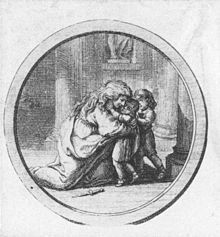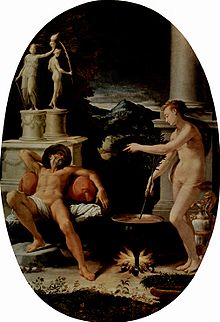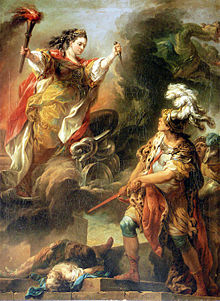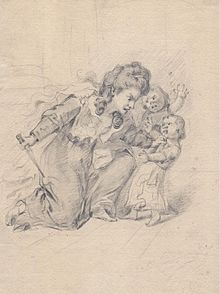Medea
![]()
The title of this article is ambiguous. For other meanings, see Medea (disambiguation).
Medea (Ancient Greek Μήδεια Mḗdeia 'the wise one') is a female figure of Greek mythology. Since antiquity, the Medea saga has been among the best-known material in world literature. It has also had a strong impact on the visual arts and music.
Medea is the magical daughter of King Aietes of Colchis on the east coast of the Black Sea. The Argonauts, a band of heroes led by Pelias' nephew Iason, travel there on behalf of King Pelias of Iolkos. They are to capture the Golden Fleece guarded by Aietes and bring it to Iolkos. Out of love, Medea helps Iason get the fleece and flees with the Argonauts. She marries Jason. In Iolkos, for his sake, she devises a ruse by which King Pelias is killed, whereupon the two leave Iolkos and settle in Corinth. There they live for some time with their two sons. Then Jason disowns Medea in order to marry the daughter of King Creon of Corinth. In revenge for this, Medea murders Creon, his daughter, and her own children. She flees to Athens and marries King Aigeus there. Thus she becomes the stepmother of the hero Theseus. In a conflict with Theseus, however, she is unable to assert herself. Therefore she has to leave the country and turns to Asia. There are different accounts of her further fate.
In antiquity, the material was adapted in both epic poetry and drama. The best-known adaptations are the Medea tragedies of Euripides and Seneca, the Argonaut epic of Apollonios of Rhodes and Ovid's version in his Metamorphoses. Since the High Middle Ages, numerous poets, writers, visual artists, and composers have taken up the Medea saga, often heavily reshaping it. In modern research, a plethora of interpretations aim to make the complex event comprehensible.

Medea on a Roman mural of the 1st century from Herculaneum in the National Archaeological Museum of Naples
Early modern period
Fiction
In the early modern period, the image of Medea was primarily influenced by the tragedies of Euripides and Seneca. The new dramatic adaptations of the material followed on from these. Dramatic reception first began in France and Italy. Apart from school theatre, performances of ancient tragedies were unusual; the material came onto the stage through performances of modern dramas as well as through opera and ballet.
Pierre Corneille
In his Médée, a juvenile work first performed in 1635, the famous French dramatist Pierre Corneille followed partly the plot of Euripides and partly the model of Seneca's tragedy. He attached great importance to plausibility. For this reason, he deviated considerably from Euripides' depiction in parts, since individual connections in the ancient work seemed inconsistent to him. He later set out his thoughts on this in an explanation, the examen. As is usual in ancient theatre, everything in Corneille's five-act play takes place on a single day (unity of time). It is the day of the infanticide. The ancient unity of place is not preserved, however, but the settings change.
In Corneille's work, it is not Medea who asks Creon for a reprieve, but he spontaneously offers her one in order to soften the severity of his banishment sentence. Jason's behaviour does not seem as irresponsible as in Euripides, but, as in Seneca, he presents a comprehensible reason. Although he is in love with Creusa, this is not the most important motive for him. Rather, his primary concern is the survival of his children, whom Creon, as his father-in-law, is supposed to protect from his bitter enemies. He even saves Medea by dissuading Creon from his plan to deliver her to Pelias' son. However, he is incapable of deep love, but confesses to his friend Pollux that he only exploits women to achieve his goals.
Corneille assigns a greatly expanded role to King Aigeus. The encounter of the King of Athens with Medea is not accidental, as in Euripides, but has a prehistory that is important for the entire constellation. The aged Aigeus has fallen violently in love with Creusa and wants to win her as a wife. He thus acts as a rival to Jason, portraying his rival as a murderer. However, the Corinthian princess rejects his proposal, not only because she loves Jason, but also because she wants to stay in her homeland. Aigeus is deeply offended by the rejection. He attempts to forcibly abduct Creusa, which he almost succeeds in doing, for his ships are in port. Jason's brave intervention, however, foils the coup d'état. Aigeus falls into captivity, but is freed by Medea's magic. Medea thus acquires a claim on his gratitude; he promises her marriage.
In contrast to the ancient tradition, in Corneille's work the fateful robe is not offered by Medea to her rival as a gift, but is demanded by her. With her greed for the robe, the king's daughter prepares her own downfall. After the death of Creon and Creusa, Jason is so distraught that he wants to kill his children because they have delivered the fatal robe, but Medea beats him to it by murdering the children, whereupon he gives himself up for dead.
Corneille commented on his play that in it he had brought the "triumph of vice" to the stage, since Medea escapes with impunity at the end, as in Euripides. His Medea is a most sinister character. The drama achieved a considerable after-effect, but also met with criticism, especially from Voltaire, who considered it unsuccessful. He criticised the lack of coherence in the characterisation and the credibility of the plot. The criticism was thus ignited precisely by the aspect of plausibility (vraisemblence, "probability"), to which Corneille had attached particular importance.
Other processing
Probably in 1553, Jean Bastier de La Péruse wrote the five-act tragedy La Médée in rhymed Alexandrians, based on the dramas of Euripides and Seneca. The humanist Lodovico Dolce published an Italian adaptation of Euripides' tragedy in 1557.
Pedro Calderón de la Barca wrote the mythological festival play Los tres mayores prodigios ("The Three Greatest Miracles"), which was first performed in 1636. The first of the three acts is about the first miracle, Jason's successful quest for the fleece and his escape with Medea. Francisco de Rojas Zorrilla published his play Los encantos de Medea ("Medea's Magic") in 1645. His Medea does not hesitate in the murder of children, which reinforces the impression of inhumanity.
The Amsterdam theatre director Jan Vos wrote the tragedy Medea in Dutch; it was first performed in 1665 and was a great success with the public.
Hilaire Bernard de Requeleyne, Baron de Longepierre wrote the tragedy Médée, first performed in 1694. Its stage success was sustained; at the time of Voltaire, who considered it very mediocre, it was the only adaptation of the material performed in Paris. For Longepierre Corneille's drama was too rationally constructed and not in harmony with sensibilité, the unerring judgment of the heart. His own tragedy conformed to the expectations of the dawning age of sensibility. Here Jason has been overcome by genuine love for Creusa, so he disregards all warnings of Medea's revenge. As in Euripides, he completely misjudges Medea's nature; he believes her to be kind-hearted and believes in her extraordinary tenderness (tendresse extrême), therefore she can deceive him effortlessly. Despite her wildness, Medea has better outward self-control in Longepierre than in the earlier tragedies.
The first English drama of Medea, Charles Johnson's Tragedy of Medæa, first performed in 1730, was a failure because it did not correspond to the taste of the time. In contrast, Richard Glover's tragedy Medea, published in 1761 and first performed in 1767, found favour. Glover made considerable changes to the traditional material. In his work, it was not the soft, wavering Jason but the tyrannical Creon who was the real antagonist of the positively drawn Medea. Glover had Medea commit the infanticide in a fit of madness in order to make the act comprehensible to the audience. Following the ancient model, he used a chorus. The performance of the famous actress Mary Ann Yates in the leading role contributed significantly to the success.
Julius Graf von Soden created the blank tragedy Medea in five acts, which revolves around the entanglements of a love triangle between Jason, Medea and Creusa. Friedrich Maximilian Klinger wrote two Medea dramas in prose: Medea at Corinth (published in 1787) and Medea on the Caucasus (published in 1791). In the first play, Medea is a demonic yet heroic, inwardly lonely figure, far removed from normal human existence. Therefore, her distance is great not only from her husband but also from her children. Jason cannot bear his dependence and inferiority, and even the children turn to the gentle Creusa, who offers an alternative to Medea's frightening nature. With the murder of the children, the demigoddess Medea returns to the world beyond the human from which she came. In Klinger's second drama, Medea is also outwardly lonely after her flight from Corinth and is plagued by regret. She tries in vain to dissuade the Caucasian barbarians among whom she now lives from the human sacrifices customary there. Finally, she inflicts death on herself.
visual arts
Andrea Schiavone made a drawing of Medea on the dragon chariot. Girolamo Macchietti created a painting around 1572 showing the rejuvenation of Aison through Medea's sorcery. In 1583-1584 Annibale Carracci and Lodovico Carracci painted frescoes in the Palazzo Ghisilardi Fava in Bologna depicting scenes from the myth, including Medea's encounter with Jason, the outwitting of the Peliades, and Aison's rejuvenation. Peter Paul Rubens drew Medea's flight on the dragon chariot. Nicolas Poussin produced two pen and ink drawings of the infanticide. Charles-Antoine Coypel depicted the triumph of Medea, unassailable on the dragon chariot, over the furious Jason in the pastel painting Jason et Médée in 1715. In 1746 Jean-François de Troy completed the cycle of paintings Histoire de Jason, which contains various scenes with Medea. Edmé Bouchardon drew The Deception of the Daughters of Pelias.
A 1759 oil painting by Carle van Loo shows the celebrated actress Claire Clairon as Medea on the dragon chariot with her dagger in her left hand, a torch in her right; the dead children lie on the stone steps, Jason draws his sword in vain. Van Loo's painting established his fame, but it was criticized by Denis Diderot as overladen and pathetic. A pen and ink drawing Medea Contemplating the Murder of Her Children, painted around 1778, was by George Romney. In 1779 Anton Hickel painted the actress Johanna Sacco as Medea. Jean Honoré Fragonard produced a chalk drawing of the Murder of Her Children.
Music
In the opera of the 17th and 18th centuries, Medea's fate was a popular subject. She first appeared on the opera stage as a protagonist in 1649; this involved only her role as Jason's lover, who beguiles the hero. It was not until 1693 that she was also shown as a child murderess. In the 18th century, the dramatic events in Corinth were mostly thematized.
Among the composers who staged operas with her as the main character or important figure - the dates in each case refer to the first performance - are Francesco Cavalli (Giasone, libretto by Giacinto Andrea Cicognini, 1649), Jean-Baptiste Lully (Thésée, libretto by Philippe Quinault, 1675), Antonio Giannettini (Medea in Atene, libretto by Aurelio Aureli, 1675), Marc-Antoine Charpentier (Médée, libretto by Thomas Corneille, 1693), Johann Christian Schieferdecker (Medea, 1700, music now lost), George Frideric Handel (Teseo, libretto by Nicola Francesco Haym, 1713), Joseph François Salomon (Médée et Jason, libretto by Simon-Joseph Pellegrin, 1713), Giovanni Francesco Brusa (Medea e Giasone, libretto by Giovanni Palazzi, 1726), Davide Perez (Medea, 1744), Georg Gebel the Younger (Medea, 1752), Josef Mysliveček (Medea, 1764), Bengt Lidner (Medea, 1774), Johann Christoph Vogel (La toison d'or, libretto by Philippe Desriaux, 1786), Johann Gottlieb Naumann (Medea in Colchide; two versions, the first premiered under a different title in 1788, the second in 1805), Gaetano Marinelli (La vendetta di Medea, 1792), Gaetano Andreozzi (Giasone e Medea, 1793), Luigi Cherubini (Médée, libretto by François-Benoît Hoffman, 1797) and Francesco Piticchio (La vendetta di Medea, 1798).
Cavalli and Cherubini achieved a particularly strong after-effect. Cavalli's Giasone became one of the most successful operas of the 17th century. It is a cheerful love story that ends reconciliatory after manifold entanglements. Cherubini's Médée is among his best-known works; performances with Maria Callas in the title role (1953-1962) contributed especially to the popularity of this opera. Here Medea is the betrayed wife, who at first tries to win back her husband by all means and finally takes devastating revenge.
In 1688 the ballet opera L'enchantement de Médée ("Medea's Enchantment") by Wolfgang Carl Briegel was premiered. In 1775 Friedrich Wilhelm Gotter wrote the text of a melodrama Medea in nine scenes; Georg Benda composed the music for it. A large monologue by Medea, interrupted several times, in which she recites her thoughts, feelings and fantasies, makes up by far the largest part of the Singspiel. In the end, she stabs the children in the royal palace, and Jason gives himself death with his sword. On stage, this melodrama achieved a success that lasted for decades. Jean-Georges Noverre choreographed his ballet Médée et Jason in 1763, which caused international enthusiasm and was part of the repertoire in various versions until the 19th century.

Daniel Chodowiecki: Title vignette for Medea by Friedrich Wilhelm Gotter

The Rejuvenation of Aison. Painting by Girolamo Macchietti, c. 1572, in the Palazzo Vecchio, Florence

Medea on the dragon chariot, drawn by Andrea Schiavone

The actress Claire Clairon as Medea in the tragedy Médée by Longepierre, painted by Carle van Loo, 1759

Mary Ann Yates as Medea in Richard Glover's tragedy
Text Collections
- Ludger Lütkehaus (ed.): Mythos Medea. Texts from Euripides to Christa Wolf. Reclam, Stuttgart 2007, ISBN 978-3-15-020006-3 (compilation of literary texts).
- Joachim Schondorff (ed.): Medea. Euripides, Seneca, Corneille, Cherubini, Grillparzer, Jahnn, Anouilh, Jeffers, Braun. Langen Müller, Munich 1963 (translations)
Questions and Answers
Q: Who is Medea in Greek mythology?
A: In Greek mythology, Medea is a sorceress and the daughter of King Aeëtes of Colchis, niece of Circe, and granddaughter of the sun god Helios.
Q: Who did Medea marry?
A: Medea married the hero Jason.
Q: How many children did Medea have with Jason?
A: Medea had two children with Jason - Mermeros and Pheres.
Q: What does Euripides' play "Medea" tell about?
A: Euripides' play "Medea" tells about how Medea avenges her husband's betrayal by killing their children after he leaves her for Creon's daughter Glauce.
Q: What are the myths involving Jason interpreted as part of?
A: The myths involving Jason are interpreted as part of a class of myths that tell how the Hellenes faced challenges from pre-Greek cultures before the Trojan War.
Q: What is known about the myth of Jason and Medea?
A: The myth of Jason and Medea is very old, originally written around the time Hesiod wrote Theogony. It was known to composer of Little Iliad, part of Epic Cycle.
Q: How is Medea often depicted in stories?
A: In most stories, Medea is depicted as an enchantress or priestess of Hecate or a witch.
Search within the encyclopedia